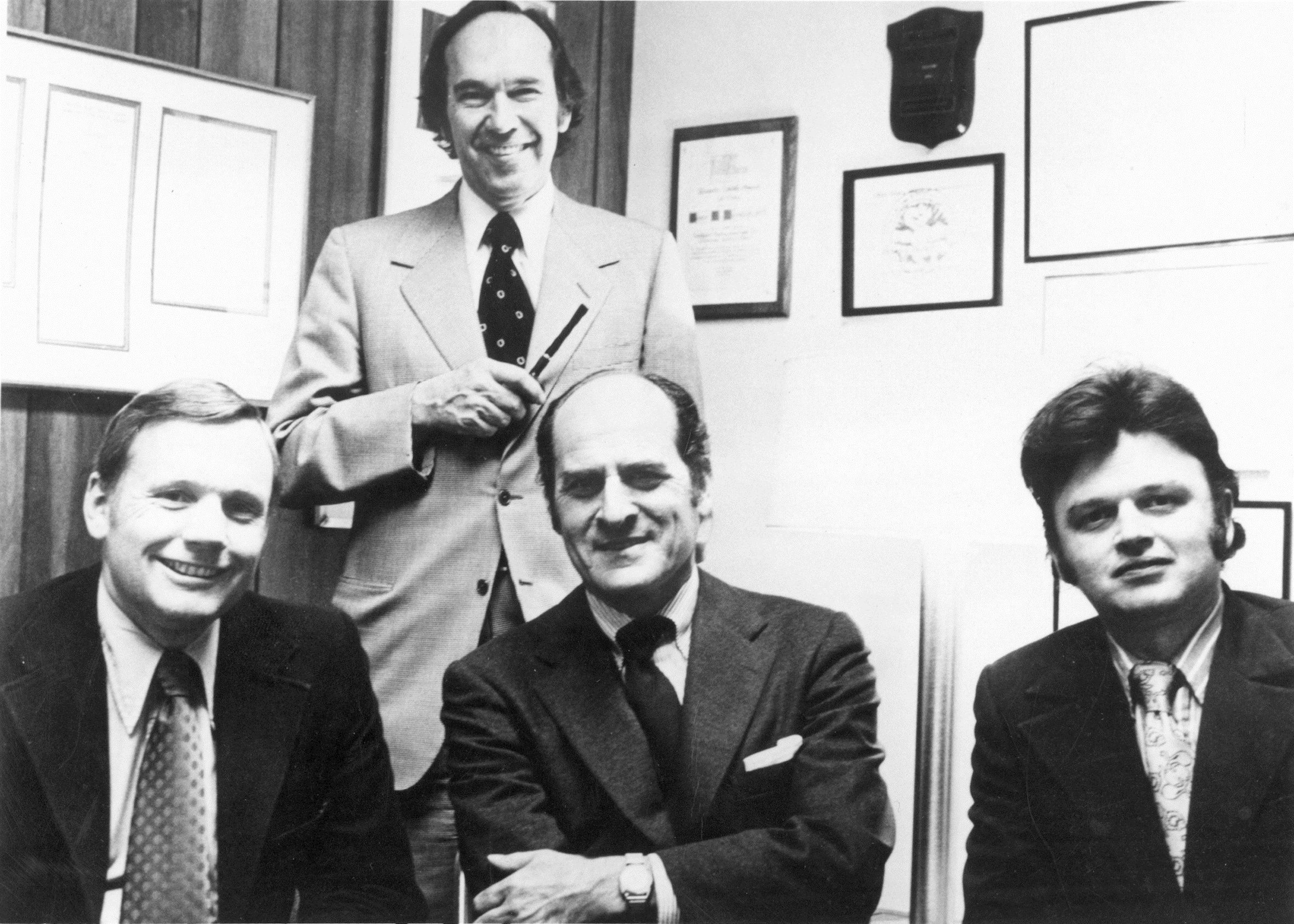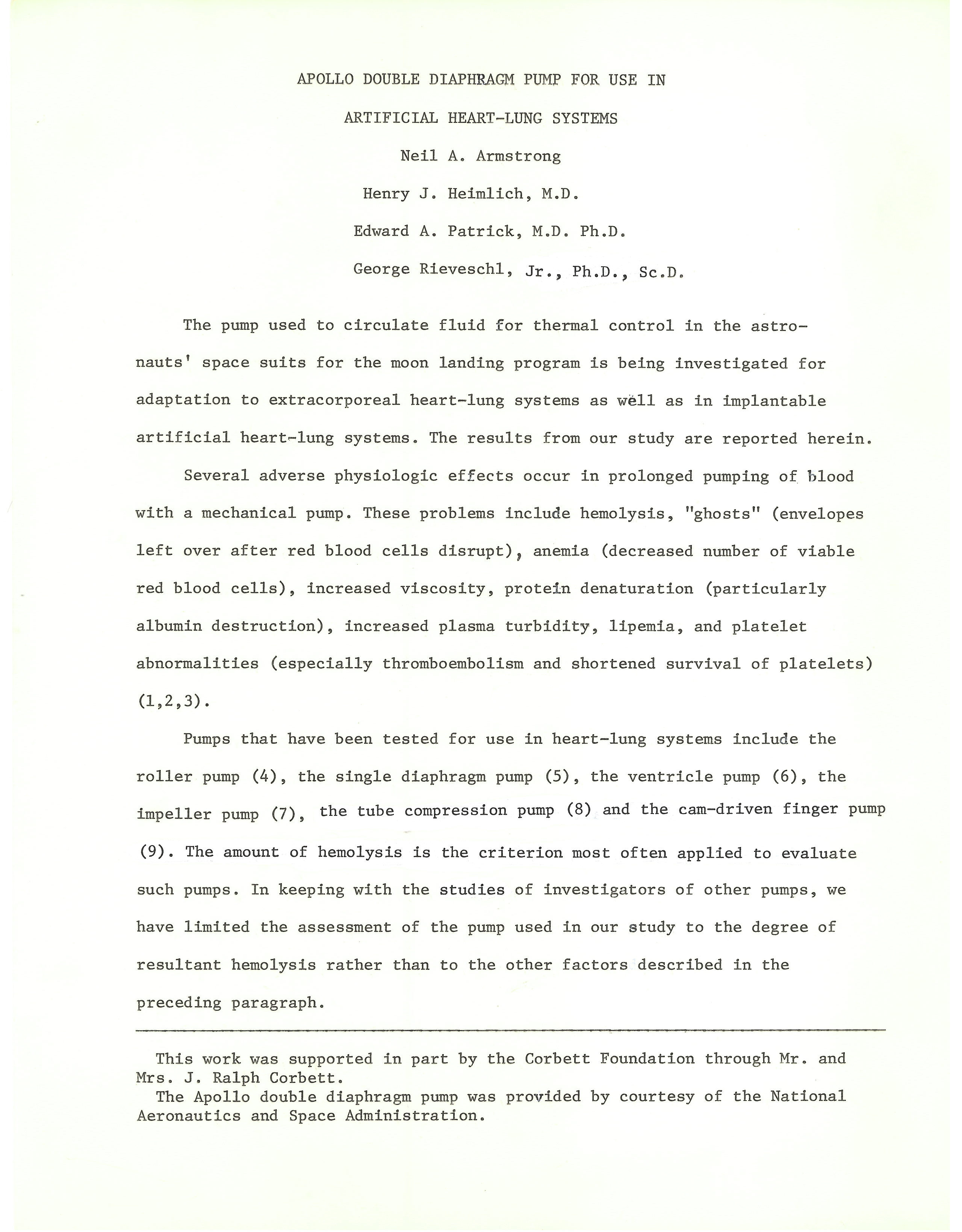Neil Armstrong’s recent death has brought him and his work back into the spotlight once again. Much attention is rightfully paid to his great accomplishments as an astronaut, especially the Apollo program and his walk on the moon. He has been called an “American Hero” more times than anyone count but despite all of that grandeur, in his own mind Armstrong remained “…a white-socks, pocket-protector, nerdy engineer, born under the second law of thermodynamics, steeped in steam tables, in love with free-body diagrams, transformed by Laplace and propelled by compressible flow”. 1

The HARP Group: Neil Armstrong, George Rieveschl, Henry Heimlich and Edward Patrick.
Photo courtesy of Kevin Grace
Armstrong’s scientific and engineering accomplishments, though rarely mentioned in traditional news media, are many and varied. In 1971 it was this “nerdy engineer” who became an important part of the University of Cincinnati Aerospace program when he came here to teach courses like Applied Aircraft Performance and Fundamentals of Flight Testing. Current head of the Department of Aerospace Engineering, Professor Awatef Hamed recalled of her former colleague “We just went to lunch and so on and so forth. We didn’t bug him and treat him like a star. He went to his office and did his work like the rest of us.”2 Armstrong was a member of the faculty at UC until 1979.
During his tenure with the University, Armstrong took on a project with a number of local medical professionals including Dr. Heimlich, Dr. Rieveschl and Dr. Patrick. The HARP Group as they were called set out to design an artificial oxygenator for the treatment of chronic lung diseases. Pumps used in heart-lung machines at the time caused severe hemolysis or rupturing of red blood cells and were often unsafe to use for more than a few hours. The result of the HARP Group’s efforts was the Apollo Double Diaphragm Pump for artificial heart-lung systems, a modified version of a pump used by NASA to circulate temperature regulating fluid in space suits. According to the team’s report, the Apollo Pump caused less hemorrhaging of red blood cells “than that reported for any other pump.” Although the pump was never completed, the research conducted lead to the design, patent and manufacture of a highly successful device called the Heimlich Micro Trach, an oxygen delivery system which allows patients to use much less oxygen than they would otherwise need by delivering the gas directly to the windpipe where it can’t escape in breath as easily. In a 1999 interview with the Cincinnati Enquirer Dr. Heimlich said of Armstrong:
“He immediately grasped the concept and joined me. Neil obtained the last two existing very small pumps that were used to circulate fluid in the space suits, in order to maintain a constant temperature. We ran tests on those pumps. … We worked together for about six years, and had wonderful meetings every week in my laboratory, stimulating and fun. We never got to complete the heart-lung apparatus, but we learned a great deal. One of the products resulting from our studies is the Micro Trach, a very tiny tube that is inserted in the trachea, or windpipe, to deliver oxygen on a permanent basis. This is widely used throughout this country and other countries.”
- T.C. “Obituary: Neil Armstrong,” The Economist, Aug 25th 2012, 20:38, http://www.economist.com/blogs/babbage/2012/08/obituary accessed September 10, 2012
- Bach, John “Still Climbing: University of Cincinnati’s Aerospace Systems School stays its course toward advancing flight,” UC Magazine, October 2011, http://magazine.uc.edu/issues/1011/aerospace.html accessed September 10, 2012
- Johnston, John; Amrhein, Sandra; Thompson, Richelle “Neil Armstrong, Reluctant Hero: The first man on the moon shuns interviews and avoids the spotlight, preferring the quiet – almost anonymous life hje has created in Southwest Ohio” [sic], July 18, 1999, http://www.enquirer.com/editions/1999/07/18/loc_neil_armstrong_the.html accessed September 10, 2012
- See box 8, folder 15 “Proposal for Development of Artificial Oxygenators for Relief and Treatment of Chronic Lung Diseases” by Neil Armstrong; Henry J. Heimlich, M. D.; Edward Patrick, M.D.; George Rieveschl, Ph. D., 1977 and box 75, folder 4 “Apollo Double Diaphragm Pump for Use in Artificial Heart-Lung Systems” by Neil A. Armstrong, Dr. Henry J. Heimlich , Dr. Edward A. Patrick and Dr. George Rieveschl with related reports, study protocol, newspaper clippings and correspondence, 1974 – 1977 of the Henry J. Heimlich Archival Collection, Henry R. Winkler Center for the History of the Health Professions, University of Cincinnati Libraries, Cincinnati Ohio

